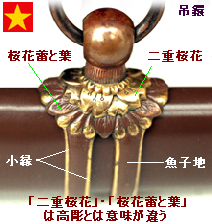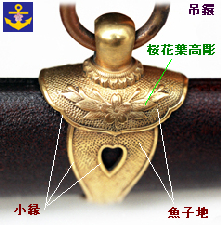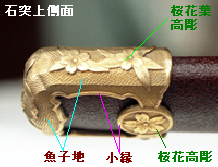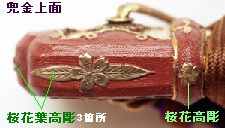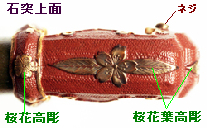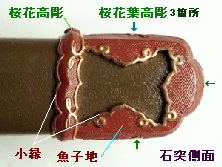
Kabuto-gane is equivalent to Kashira in Uchigatana Koshirea
Ishi-zuki is eqivalent to Kojiri in Uchigatana Koshirae
Kuchi-gane is eqivalent to Kouguchi in Uchigatana Koshirae
Chiyokan is equivalent to Ashi + Obi-tori in Tachi KoshiraeKobuchi indicates the boundary of various metal parts (Kanagu), Fuchi-dori. Takahori means high embossed carving. Many metal parts have sakura and sakura leaf carvings. High level carving indicates high quality. However, Kabuto-gane and Ishi-zuki are different. If you look carefully, in Kabuto-gane and Ishi-zuki, very thin metal sheets of sakura (with leaves) shape are firmly "attatched" on Nanakozi. Nanakozi means the surface of various metal parts which looks like fish eggs.
Gunto Tsuka

Tsukaki (Tsuka wood) is made by attaching two base wood pieces (Honoki) with speical glue called Soku. Then, Samegawa is covered to fortify Tsukaki and prevent the slippery of hands when grasped. Samegawa with Eyatsubu is regarded as high quality. Army hangs Kijinomama andnavy used Kuro-urushi. Thin wood papers called Kiyougi are attached on sides. Mekugi is made of bamboo.
Tsuka-maki

Morohineri-maki In army,
Morohineri-maki was standard but
|

Hiromaki In navy,
Morohineri-maik and Hiromaki were
|
Kanamono no TakahoriArmy : Sakura & leaves=> 3 pieces in kabuto-gane and ishi-zuki, 6 pieces in fuchi and kuchi-gane. Sakura => 1 piece in kabuto-gane and ishi-zuki. There is stacked sakura & leaves and double sakura in chyokan but these are different from takahori (engraving).
Navy : Sakura & leaves => 6 pieces in kabuto-gane and ishi-zuki, 4 pieces in fuchi and kuchi-gane, 2 pieces in each chyokan. Sakura => 2 piece in kabuto-gane and ishi-zuki
=>
Blade
Holder
